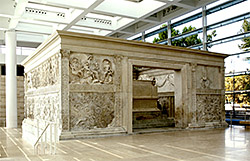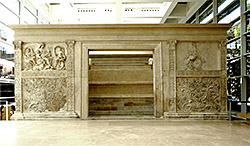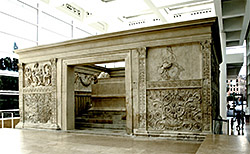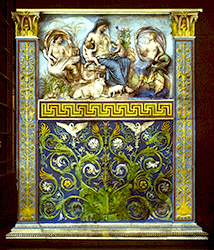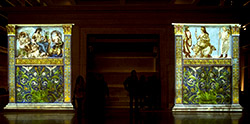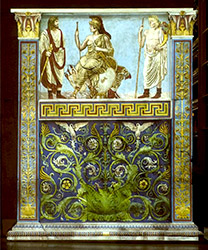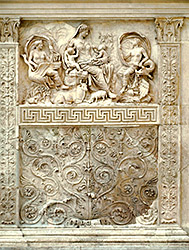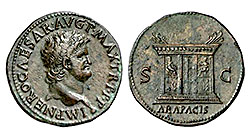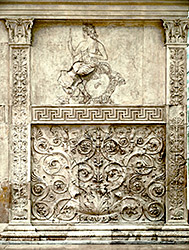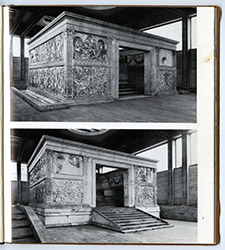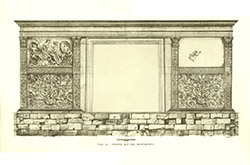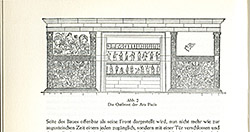Public Approach Front
original east front
Facade
Back, Front, East, West? This facade of the surrounding precinct wall is usually decribed as the "back" because it has been seen as such by the public since the Ara Pacis was first installed in its 1937-38 pavillion. But to call this facade the "back" distorts the character of the surrounding precinct wall. The sacrificial altar within has a front and back, but the surrounding precinct wall has two opposite, corresponding fronts. This is an essential aspect of the design and meaning of the Ara Pacis.
The 1937-38 pavilion in which the Ara Pacis was reconstructed had entries at both ends, corresponding to the entries in both front facades of the Ara Pacis. But the doors at the southern end of the pavilion were most used and the southern end of the pavilion thus considered its entrance. Correspondingly the northern end of the pavilion was considered its back entrance. Unfortunately this increased the tendency to call the Ara Pacis facade at the northern end of the pavilion the "back" of the Ara Pacis. This misconception has been increased by the design of the new Ara Pacis Museum in which this facade of the Ara Pacis, originally facing the main public thoroughfare, now faces what is clearly the back of the great hall, facing a stone wall instead of the previous glass wall with entry doors.
Some scholars have argued, quite persuasively, that this facade of the Ara Pacis was the public front, because it faced the Via Flaminia, the main public avenue on which the Ara Pacis fronted. Moreover, all but one of the ancient images that seem to represent the Ara Pacis are on coins that represent this original east facade. The term "back" distorts the meaning of this major facade. I consider the term "back" inappropriate for any aspect of the enclosing precinct wall, one of whose formal characteristics is pervasive balance, side-to-side and end-to-end. It is best that we think of and describe the Ara Pacis as having two opposite fronts.
This facade is also referred to as the "east". However, I prefer not to rely on this term alone because it is not intuitively obvious to most people and can even be misleading, because what is sometimes called the "east", its approximate original orientation, faces north as reconstructed in 1938 and seen today. I prefer to describe this as the "Public Approach Front". Ocasionally I use the term "original east front" or even, for brevity, "east front" (but never "east" alone).
Originally Painted? As with so many ancient monuments, the original surface of the Ara Pacis was not lightly toned marble but instead brightly colored paint.
Without this essential aspect of the imagery, interpretations of meaning are necessarily incomplete and in part speculative. In recent years, increasing attempts have been made to suggest the original appearance of various ancient monuments, not only of Greece and Rome but also of India, China, and Pre-Columbian America. The recently proposed reconstructions of the Ara Pacis colors are now impressively demonstrated with color projection directly on the front facades. Based largely on parallels with Roman wall paintings, they are especially to be applauded because they suggest the partly naturalistic appearance of the originals, instead of the flat, cartoon-like treatment of many color reconstructions.
TO ZOOM IN ON THE LARGE IMAGES, USE THE BUTTONS AT TOP-LEFT.
Tips for using this website
